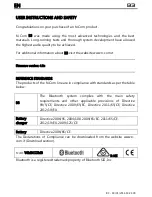
#
Pull plug
4
with the cable and hose
5
out
of the tire inflation compressor housing.
#
Push the plug of hose
5
into flange
6
of
tire sealant bottle
1
, until the plug engages.
#
Place tire sealant bottle
1
head downwards
into recess
2
of the tire inflation compres‐
sor.
#
Remove the cap from valve
7
on the faulty
tire.
#
Screw filling hose
8
onto valve
7
.
#
Insert plug
4
into a 12 V socket in your
vehicle.
#
Switch on the ignition.
#
Press on and off switch
3
on the tire infla‐
tion compressor.
The tire inflation compressor is switched on.
The tire is inflated. First, tire sealant is pum‐
ped into the tire. The pressure may briefly
rise to approximately 500 kPa (5 bar/73 psi).
Do not switch off the tire inflation compres‐
sor during this phase.
#
Let the tire inflation compressor run for a
maximum of ten minutes.
The tire should then have attained a tire
pressure of at least 200 kPa (2.0 bar/
29 psi).
If tire sealant leaks out, make sure you clean the
affected area as quickly as possible. It is prefera‐
ble to use clean water.
If you get tire sealant on your clothing, have it
cleaned as soon as possible with perchloroethy‐
lene.
If, after ten minutes, a tire pressure of
200 kPa (2.0 bar/29 psi) has not been ach‐
ieved:
#
Switch off the tire inflation compressor.
#
Unscrew the filler hose from the valve of the
faulty tire.
Please note that tire sealant may leak out when
unscrewing the filling hose.
Breakdown assistance 297
Summary of Contents for E-class
Page 7: ...5 ...
Page 8: ...6 At a glance Cockpit ...
Page 10: ...Instrument display standard 8 At a glance Cockpit ...
Page 12: ...Instrument display in the Widescreen Cockpit 10 At a glance Warning and indicator lamps ...
Page 14: ...12 At a glance Overhead control panel ...
Page 16: ...14 At a glance Door control panel and seat adjustment ...
Page 18: ...16 At a glance Emergencies and breakdowns ...
Page 444: ...442 ...
Page 445: ...443 ...
Page 446: ...444 ...
















































